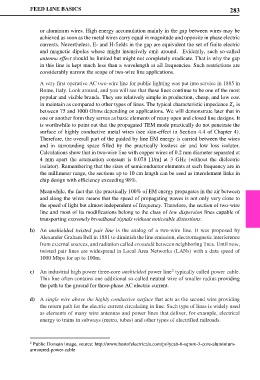Page 303 - Maxwell House
P. 303
FEED LINE BASICS 283
or aluminum wires. High energy accumulation mainly in the gap between wires may be
achieved as soon as the metal wires carry equal in magnitude and opposite in phase electric
currents. Nevertheless, E- and H-fields in the gap are equivalent the set of finite electric
and magnetic dipoles whose might intensively emit around. Evidently, such so-called
antenna effect should be limited but might not completely eradicate. That is why the gap
in this line is kept much less than a wavelength at all frequencies. Such restrictions are
considerably narrow the scope of two-wire line applications.
A very first operative AC two-wire line for public lighting was put into service in 1885 in
Rome, Italy. Look around, and you will see that these lines continue to be one of the most
popular and visible brands. They are relatively simple in production, cheap, and low cost
in maintain as compared to other types of lines. The typical characteristic impedance is
between 75 and 1000 Ohms depending on applications. We will demonstrate later that in
one or another form they serves as basic elements of many open and closed line designs. It
is worthwhile to point out that the propagated TEM mode practically do not penetrate the
surface of highly conductive metal wires (see skin-effect in Section 4.4 of Chapter 4).
Therefore, the overall part of the guided by line EM energy is carried between the wires
and in surrounding space filled by the practically lossless air and low loss isolator.
Calculations show that in two-wire line with copper wires of 0.2 mm diameter separated at
4 mm apart the attenuation constant is 0.078 [1/m] at 3 GHz (without the dielectric
isolator). Remembering that the sizes of semiconductor elements at such frequency are in
the millimeter range, the sections up to 10 cm length can be used as interelement links in
chip design with efficiency exceeding 98%.
Meanwhile, the fact that the practically 100% of EM energy propagates in the air between
and along the wires means that the speed of propagating waves is not only very close to
the speed of light but almost independent of frequency. Therefore, the section of two-wire
line and most of its modifications belong to the class of low dispersion lines capable of
transporting extremely broadband signals without noticeable distortions.
b) An unshielded twisted pair line is the analog of a two-wire line. It was proposed by
Alexander Graham Bell in 1881 to diminish the line emission, electromagnetic interference
from external sources, and radiation called crosstalk between neighboring lines. Until now,
twisted pair lines are widespread in Local Area Networks (LANs) with a data speed of
1000 Mbps for up to 100m.
2
c) An industrial high power three-core unshielded power line typically called power cable.
This line often contains one additional so-called neutral wire of smaller radius providing
the path to the ground for three-phase AC electric current.
d) A single wire above the highly conductive surface that acts as the second wire providing
the return path for the electric current circulating in line. Such type of lines is widely used
as elements of many wire antennas and power lines that deliver, for example, electrical
energy to trains in subways (metro, tubes) and other types of electrified railroads.
2 Public Domain image, source: http://www.bestofelectricals.com/polycab-6-sqmm-3-core-aluminium-
armoured-power-cable

